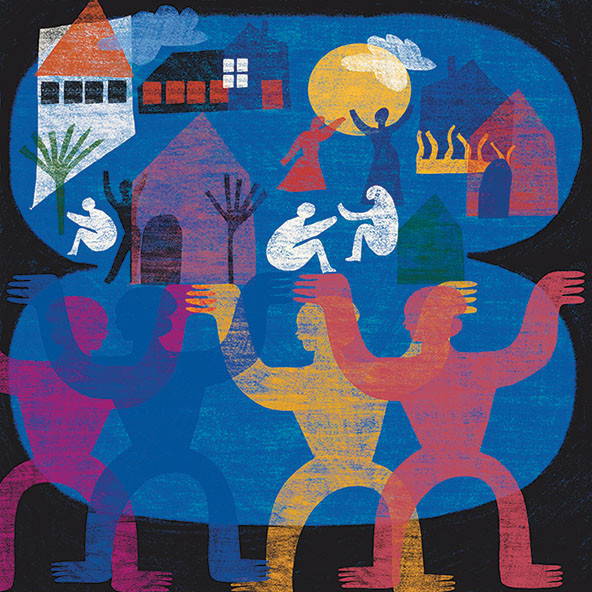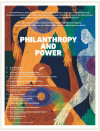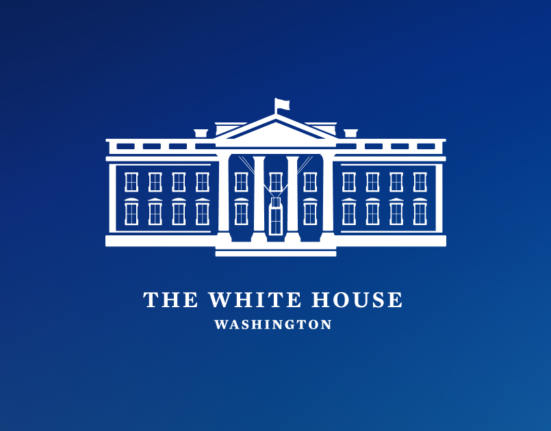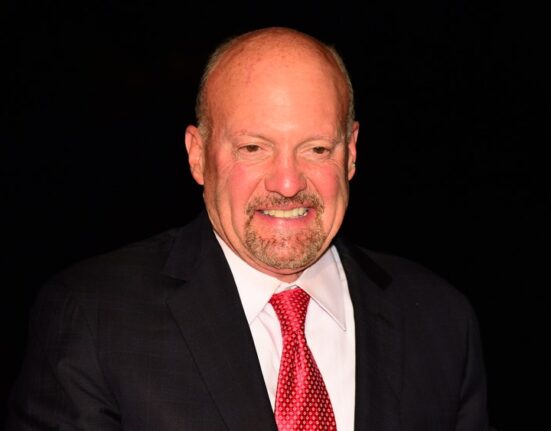
(Illustration by Diana Ejaita)
At Intelligent Mischief, our purpose is to boost invention and imagination, realign action logic, and experiment with new forms of culture and civil society to create atmospheres of change. We do this work because we are waging an imagination battle, as our founder, Terry Marshall, explained in Emergent Strategy, adrienne maree brown’s 2017 book. This battle is for the meaning of the future of the world. Our work is imagination activism that seeks to build the power of working-class, Black communities to advance a collective political imaginary grounded in love, care, regeneration, and interdependence.
Philanthropy and Power
If philanthropy is going to play a constructive role in creating a more just and equitable world, foundations and donors need to be accountable for the power they hold, creative in how they share it, and ultimately bold in handing it over to the communities they serve. Sponsored by the Chorus Foundation.
Increasingly, many people believe that human life is inherently nasty, brutish, and short, that resources are scarce, and that each of us acts as a solitary individual who must compete for limited resources to ensure our own survival. This notion underpins much of our political economy and reinforces capitalism’s hegemonic power to commodify, exploit, and extract from all life to support the survival of a few.
In this paradigm, culture plays the role of normalizing a capitalist worldview and its associated values, norms, behaviors, and structures to such an extent that we believe that no alternative is possible. To survive, we are told, we must win at competition. In fact, competition is perhaps the most pervasive value in this social imaginary. We compete for market share, jobs, housing, love, attention, health, and in the social sector, funding. Narratives of competition and scarcity saturate our culture in both direct and subtle ways. Structures of competition and scarcity force us to battle one another, reinforcing the belief that not all of us will survive, but that I must survive at any cost. The premise of an imagination battle also suggests competition as an ideology (alongside individualism and consumerism).
But there is another imaginary, or rather, there are many other imaginaries that share the belief that life is emergent, beautiful, chaotic, and unpredictable, but also that resources are abundant when shared, and that we survive and thrive together in interdependent relationships with one another, the land, and other beings.
This is a worldview broadly embraced by Indigenous communities and grounded in values of abundance, care, and community. In contemporary US culture, there are songs, books, and games about sharing and caring, especially to teach young children about cooperation and collaboration, that reinforce this worldview. Historically, many cultures have been shaped by some combination of these imaginaries. While sometimes difficult to see, these imaginaries still underpin our political, economic, and cultural conflicts and guide our assumptions about how the future will look.
The extent to which these pro-social ideas shape our behaviors, values, and systems is determined by their power to capture our imaginations. The imagination battle is waged largely in the realm of culture: on social media, in entertainment, in play and leisure, in education systems, in religious spaces, and more.
In 2016, Intelligent Mischief wrote an article called “Contending for Dreamspace,” where we advocated for a greater focus on cultural strategy within the social justice left. We subsequently delivered a talk by the same name to an audience of artists and social justice activists at the offices of the Open Society Foundations. In this talk we discussed a critical element of our purpose statement: atmospheres of change, a cultural strategy based on what it might take to build cultural power for an imaginary that is undergirded by values of love, care, regeneration, and interdependence.
We think of culture as the air or atmosphere that moves around us, through us, and between us. It is all that constitutes what we understand as society or social culture. It is the stone soup of our beliefs, ideologies, values, assumptions, myths, behaviors, structures, systems, institutions, identities, workplaces, hobbies, economies, and more. Culture is what underpins our political and economic systems. It is also the manifestation of our political and economic decisions. Indeed, culture is who we are and what we do.
What might it look like for the progressive left to cultivate an ecosystem that advances a worldview of love, care, regeneration, and interdependence?
If culture is all that we believe, value, do, and create, then cultural power is the ability to shape what we believe, what we value, what we do, and what we create. It is the power to decide what imaginary shapes our society. In recent years, significant philanthropic and institutional investments have sought to build narrative power on the left. If successful, these investments will enhance our ability to shape stories that promote progressive, radical assumptions and ideas about who we are as a society, who is included, and who is represented. Funding collaboratives such as the Pop Culture Collaborative and entities such as the Narrative Initiative are innovating within the left to advance pluralist narratives and build narrative ecosystems to move progressive ideas into the mainstream.
Even so, narrative power alone does not constitute cultural power. An implicit assumption in our investment in narrative power is that shaping stories and ideas will result in a shift in behaviors and practices and eventually, institutions and systems. But building the power to shape narratives is only one component of building cultural power. Social transformation requires us to shift narratives, but also to reshape behavioral norms and systems by creating vast, robust networks, institutions, and ecosystems that can sustain those narrative and behavioral shifts in the long term. For example, media narratives that remind us of Indigenous sovereignty, such as land acknowledgements, are made even more powerful by rematriation initiatives such as the Sogorea Te Land Trust.
Mainstream cultural institutions exist in consort with political and economic structures to reinforce a dominant/hegemonic culture, which views systems of control, extraction, and violence as normal and acceptable. Within this paradigm, narrative power is mediated through institutions such as the media, Hollywood, religion, and education. Subcultural narratives and infrastructure that challenge these dominant narratives and institutions exist, but their relative power is limited.
What does it look like for the progressive/just-transition left to build the power needed to shift culture at the scale that is required to achieve some of our most urgent goals?
We must build a cultural power ecosystem—in other words, a form of cultural power that reflects the future we wish to see. This cultural power ecosystem is interdependent, regenerative, life affirming, and nourishing. It has the capacity to influence culture and shift economic and political realities. It eschews power structures of domination, competition, and extraction while generating the resilience that is required to navigate a systemic transition.
What Does This Ecosystem Look Like?
Culture is all around us. It exists most clearly in our cultural industries or sectors (such as art, entertainment, and theater) but also within our social, economic, and political institutions, the places where our worldviews become embodied and collectively reinforced. This list includes our families, schools, religious institutions, workplaces, areas of governance, and so on.
What might it look like for the progressive left to cultivate an ecosystem that intentionally and systematically advances a worldview of love, care, regeneration, and interdependence through our institutions so that a future based on that worldview becomes irresistible and eventually inevitable? What is already taking place that might be scaled, replicated, and shared more widely?
Let’s consider some forms of culture:
Art | How might we cultivate an arts ecosystem that advances the narratives, visions, and assumptions of our progressive movements, both in terms of subject matter and the process of making, sharing, and owning art? We might look to the work of the Center for Cultural Power (CCP), which is building the power of artists and culture bearers who are Black, Indigenous, and people of color at the intersection of art, culture, and social justice. CCP is building the Constellations Fund to support artists and culture bearers of color.
Architecture | How might we design buildings that reflect values of equity, accessibility, and sustainability and that engage the population in embodied experiences of Black liberation and Indigenous sovereignty vis-à-vis materials, the stories of past, present, and future they tell, the healing they provide, and more? We might turn to The Black Reconstruction Collective, which is committed to multidisciplinary work that is dedicated to dismantling white supremacy and hegemonic whiteness within art, design, and academia. They created a groundbreaking exhibition in 2021 at the Museum of Modern Art conveying speculative architectural concepts that center Black thriving.
Academia | How might we develop academic institutions and programs that advance liberatory worldviews, Indigenous-centered structures and subjects, sustainability, and regenerative practices of repair and healing? As a model, we can turn to Ijeruka, a digital learning community that curates immersive online courses and conversations with visionary African and Afro-diasporic minds about the self and social and systemic change.
Entertainment | How might we cultivate media that advances narratives that encourage love, regeneration, and interdependence and that represent the vast diversity of our stories? How might we support media that advances the dignity of all workers and that accurately portrays our histories and futures? We might turn to the Pop Culture Collaborative, a philanthropic resource and funder learning community working to transform the narrative landscape in America around people of color, immigrants, refugees, Muslims, and Indigenous peoples, especially women, queer, and transgender and/or disabled individuals.
Ritual, Cereony, and Spiritual Traditions | How might we create opportunities for ritual, ceremony, and spirit-centered life that invite us to heal, embody re-Indigenized worldviews, and reconnect to our various ancestral traditions? We might turn to Ancestors In Training, which cultivates reconnection to earth-based practices among Afro-diasporic peoples.
Community-Based Storytelling | How might we support community theater, parades, festivals, and gatherings that tell the stories of all of us? We might learn from Buffalo, New York, which since 1976 has hosted one of the largest Juneteenth celebrations in the country and is home to Ujima Theater Company, which produces plays by and about the city’s Black community.
Nightlife | How might we create nightlife that shapes and embodies our worldviews by practicing safety and care for people of all genders and providing equitable pay for workers? We might turn to Papi Juice, an art collective that aims to affirm and celebrate the lives of queer and trans people of color. Structured around curated events, Papi Juice lives at the intersection of art, music, and nightlife.
Music | How might we cultivate a music industry that embodies our worldviews by championing the dignity and value of all music-industry workers, equitably distributing the vast wealth generated within the industry and providing care and healing for all performers? We might turn to Resonate Coop, the first community-owned music streaming service, a multistakeholder platform cooperative that is democratically governed by its members: artists, listeners, and workers.
Retail | How might we advance an economic sector that offers opportunities to embody our worldviews by internalizing the externalities of supply chains, demanding sustainability and equity, and operating as a conduit for care, community, and connection? We might look to the US Federation of Worker Cooperatives, the national grassroots membership organization for worker cooperatives and democratic workplaces.
Social Media | How might we cultivate a social media and technology sector that advances and embodies narratives of care and community by implementing equitable labor practices, energy sustainability, and democratic ownership? We can turn to New Public, a platform that connects designers and technologists to build thriving digital spaces.
Reflecting on these and other initiatives, I see that the core of a progressive cultural power ecosystem already exists. There are organizations and institutions across every realm of culture where people are cultivating narratives of love, interdependence, and regeneration to sustain these values for the long term. But compared to our dominant cultural institutions, these entities are few and small, if not experimental.
To scale, replicate, and share these approaches and build the power needed to shape local and regional cultures that influence local and regional political economies, we will need an investment far greater than what philanthropy currently awards. We will need bold and robust investments to build a cultural ecosystem that is able to fully engage in the imagination battle at scale. We will need investments that allow for building flexible legal structures that can meaningfully operate through transition and take the lead in shaping the next system.
Support SSIR’s coverage of cross-sector solutions to global challenges.
Help us further the reach of innovative ideas. Donate today.
Read more stories by Aisha Shillingford.







